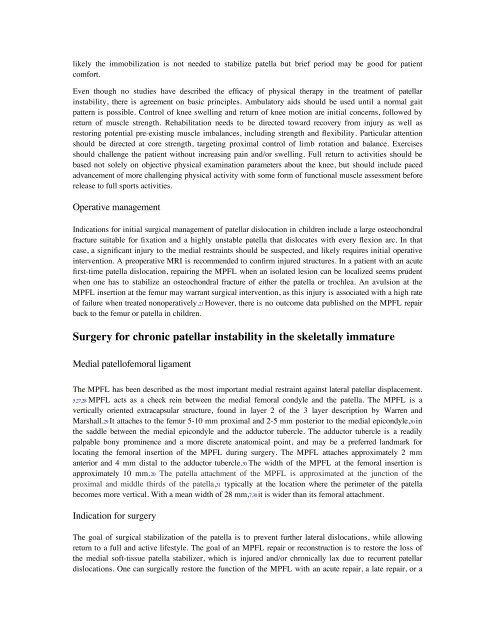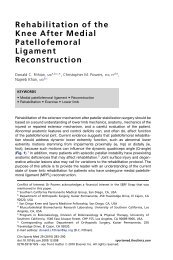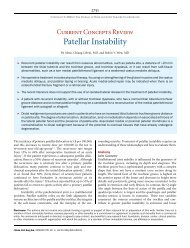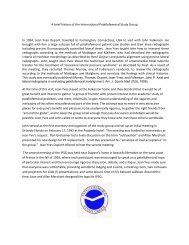Treatment of Patellar Dislocation in Children
Treatment of Patellar Dislocation in Children
Treatment of Patellar Dislocation in Children
You also want an ePaper? Increase the reach of your titles
YUMPU automatically turns print PDFs into web optimized ePapers that Google loves.
likely the immobilization is not needed to stabilize patella but brief period may be good for patient<br />
comfort.<br />
Even though no studies have described the efficacy <strong>of</strong> physical therapy <strong>in</strong> the treatment <strong>of</strong> patellar<br />
<strong>in</strong>stability, there is agreement on basic pr<strong>in</strong>ciples. Ambulatory aids should be used until a normal gait<br />
pattern is possible. Control <strong>of</strong> knee swell<strong>in</strong>g and return <strong>of</strong> knee motion are <strong>in</strong>itial concerns, followed by<br />
return <strong>of</strong> muscle strength. Rehabilitation needs to be directed toward recovery from <strong>in</strong>jury as well as<br />
restor<strong>in</strong>g potential pre-exist<strong>in</strong>g muscle imbalances, <strong>in</strong>clud<strong>in</strong>g strength and flexibility. Particular attention<br />
should be directed at core strength, target<strong>in</strong>g proximal control <strong>of</strong> limb rotation and balance. Exercises<br />
should challenge the patient without <strong>in</strong>creas<strong>in</strong>g pa<strong>in</strong> and/or swell<strong>in</strong>g. Full return to activities should be<br />
based not solely on objective physical exam<strong>in</strong>ation parameters about the knee, but should <strong>in</strong>clude paced<br />
advancement <strong>of</strong> more challeng<strong>in</strong>g physical activity with some form <strong>of</strong> functional muscle assessment before<br />
release to full sports activities.<br />
Operative management<br />
Indications for <strong>in</strong>itial surgical management <strong>of</strong> patellar dislocation <strong>in</strong> children <strong>in</strong>clude a large osteochondral<br />
fracture suitable for fixation and a highly unstable patella that dislocates with every flexion arc. In that<br />
case, a significant <strong>in</strong>jury to the medial restra<strong>in</strong>ts should be suspected, and likely requires <strong>in</strong>itial operative<br />
<strong>in</strong>tervention. A preoperative MRI is recommended to confirm <strong>in</strong>jured structures. In a patient with an acute<br />
first-time patella dislocation, repair<strong>in</strong>g the MPFL when an isolated lesion can be localized seems prudent<br />
when one has to stabilize an osteochondral fracture <strong>of</strong> either the patella or trochlea. An avulsion at the<br />
MPFL <strong>in</strong>sertion at the femur may warrant surgical <strong>in</strong>tervention, as this <strong>in</strong>jury is associated with a high rate<br />
<strong>of</strong> failure when treated nonoperatively.21 However, there is no outcome data published on the MPFL repair<br />
back to the femur or patella <strong>in</strong> children.<br />
Surgery for chronic patellar <strong>in</strong>stability <strong>in</strong> the skeletally immature<br />
Medial patell<strong>of</strong>emoral ligament<br />
The MPFL has been described as the most important medial restra<strong>in</strong>t aga<strong>in</strong>st lateral patellar displacement.<br />
5,27,28 MPFL acts as a check re<strong>in</strong> between the medial femoral condyle and the patella. The MPFL is a<br />
vertically oriented extracapsular structure, found <strong>in</strong> layer 2 <strong>of</strong> the 3 layer description by Warren and<br />
Marshall.29 It attaches to the femur 5-10 mm proximal and 2-5 mm posterior to the medial epicondyle,30 <strong>in</strong><br />
the saddle between the medial epicondyle and the adductor tubercle. The adductor tubercle is a readily<br />
palpable bony prom<strong>in</strong>ence and a more discrete anatomical po<strong>in</strong>t, and may be a preferred landmark for<br />
locat<strong>in</strong>g the femoral <strong>in</strong>sertion <strong>of</strong> the MPFL dur<strong>in</strong>g surgery. The MPFL attaches approximately 2 mm<br />
anterior and 4 mm distal to the adductor tubercle.30 The width <strong>of</strong> the MPFL at the femoral <strong>in</strong>sertion is<br />
approximately 10 mm.20 The patella attachment <strong>of</strong> the MPFL is approximated at the junction <strong>of</strong> the<br />
proximal and middle thirds <strong>of</strong> the patella,31 typically at the location where the perimeter <strong>of</strong> the patella<br />
becomes more vertical. With a mean width <strong>of</strong> 28 mm,7,30 it is wider than its femoral attachment.<br />
Indication for surgery<br />
The goal <strong>of</strong> surgical stabilization <strong>of</strong> the patella is to prevent further lateral dislocations, while allow<strong>in</strong>g<br />
return to a full and active lifestyle. The goal <strong>of</strong> an MPFL repair or reconstruction is to restore the loss <strong>of</strong><br />
the medial s<strong>of</strong>t-tissue patella stabilizer, which is <strong>in</strong>jured and/or chronically lax due to recurrent patellar<br />
dislocations. One can surgically restore the function <strong>of</strong> the MPFL with an acute repair, a late repair, or a






